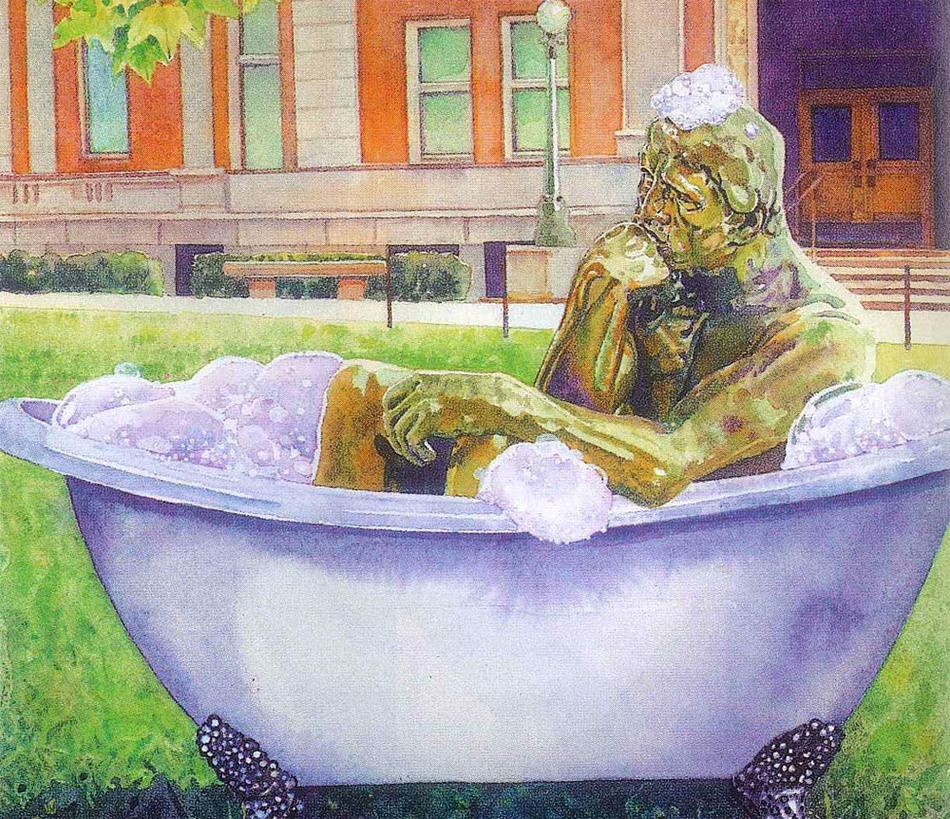Hunched in the deep early morning shade of Philosophy Hall, he seemed more naked than usual. Two people on green stepladders were stroking his back and his thigh with fat round brushes, dipped occasionally into muddy-looking cans. Flames suddenly shot out from behind his left buttock. After scrutinizing a small patch of skin, or rather bronze, one of the workers, Patty Miller ’00GSAPP, stepped down and turned off her blowtorch.
“We’re doing a maintenance cleaning and rewaxing,” she explained, staring appraisingly at Auguste Rodin’s The Thinker, who in turn stared down at the lawn. “It’s a microcrystalline wax with a corrosion inhibitor.” The propane torches are used to heat the surface of the bronze, so that the paste wax liquefies and spreads evenly when it goes on.
A senior conservator project manager with Conservation Solutions, Inc. (CSI), located outside Washington, D.C., Miller is working side by side with Ryan Greene, a sculptor who also is learning the conservation trade. She and two other principals of CSI are graduates of Columbia’s Department of Historic Preservation program, the first in the country and the pioneer training center for artists and historians in a profession that sprang up in response to the tragic destruction of New York’s Penn Station, a Beaux-Arts masterpiece razed in 1964. CSI founder Joseph Sembrat ’93GSAPP, a metals specialist, wrote his master’s thesis on “The Conservation of Outdoor Bronze Statuary.” Assistant Conservator and Project Manager Justine Posluszny earned her Master of Science in 2007.
Miller, who does metals, masonry, and plastics, began as a bronze caster at the School of the Art Institute of Chicago, one of very few city art schools to still house a foundry. She’s become an expert in testing and assessment, working in a CSI laboratory in Maryland.
“We use a lot of artists as technicians, implementing treatments we develop through research,” she said. “As a senior conservationist, I direct the work. Over at Riverside Church, I have other artists, many of them local, working on stone.” She takes out a photograph of a badly decayed carved limestone cherub with only part of a face. “You can see it’s a lifesaving issue. For something like this, we will sometimes just stabilize what’s left, or we’ll do composite repairs, attaching more material and then sculpting it to match the original.”
Much of CSI’s restoration work takes place outdoors, and is therefore seasonal, and the conservationists go in teams. In New York, they live in sublets while dividing their time among Columbia campus sculptures and other jobs, often at the Metropolitan Museum or the New York Public Library. They have home bases, but otherwise they’re like any other itinerant workers. “My dog has grandparents. Otherwise it would be impossible,” Miller said. Greene shrugged. “I don’t even own a plant.”
Although The Thinker is only about six feet tall, the figure is complex, curled and twisted, and the head, at close range, looks gigantic. “It can take up to a week to do a simple treatment like this,” Miller explained, nodding toward the statue. “A lot depends on what we need to do to remove existing coatings, including wax, and whether there’s patination that must be done first.”
How often does a statue need to be waxed?
Sarah Weiner, curator of Art Properties and director of Columbia’s Miriam & Ira D. Wallach Gallery, says that sculptures should be washed and waxed annually. “But even with regular maintenance, after some years bits of wax pop off, the metal is exposed, and it becomes corroded. When that happens, we’ve just got to work on them.”
Weiner has known Sembrat for 10 years. CSI restored Athena, in Low Library, and Alma Mater, and this time they’re working on four pieces. “CSI wasn’t chosen because they’re Columbia graduates,” she said. “We have worked with other sculpture conservators, with less good results.” Restoration is always an expensive proposition, so it pays to do it right the first time. The ticket to restore Clement Meadmore’s Curl, in front of the business school — “in disastrous condition,” Weiner lamented — could run as high as $200,000, which includes hiring a crane to move it off campus. “These days, when we accept a gift of outdoor sculpture, the donor will often give an endowment for maintenance as well.”
The Thinker was a gift from Nicholas Murray Butler, president of Columbia from 1902 to 1945, who ordered the cast in 1930 from Rodin’s original foundry. In the era before acid rain, no one could have foreseen what 78 years of weather could wreak on a sculpture’s complexion.
But Miller and Greene were making progress: an all-over bronze color began to unify what had been a streaky surface. “We also did some repatination to bring down the greenish copper-sulfate appearance,” Miller said. But doesn’t the green stuff make it look old and interesting? Miller smiled. “There’s a broad dialogue in conservation about patina, about age being part of the artwork,” she answered diplomatically. “But not all patinas are protective; some are a matter of corrosion.”
Picking up her blowtorch, she smoothed away some more of The Thinker’s age spots.



